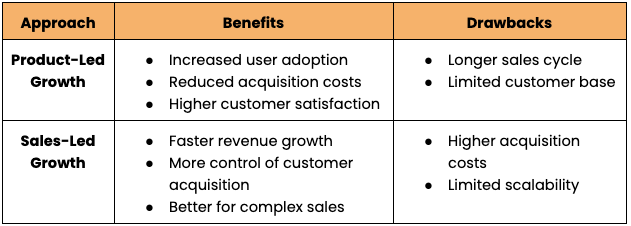Product-led growth is when a company focuses on creating a great product and letting that product speak for itself, relying on word-of-mouth marketing and user referrals to grow. On the other hand, sales-led growth is when a company prioritizes building a strong sales team and using direct outreach and marketing tactics to bring in new customers.
Related Read: Lead Generation for SaaS Companies: 5 Innovative Strategies
Product-led growth has gained significant attention in recent years due to the rise of software-as-a-service (SaaS) companies. SaaS is a natural fit for product-led growth due to the easy ability to offer free trials and freemium versions of solutions. This self-serve approach has led to many successful companies like Dropbox and Slack, which have grown primarily through word-of-mouth referrals.
On the other hand, sales-led growth has been the traditional approach for many businesses, especially those selling physical products. In this approach, your organization will build a strong sales team that can reach out to potential customers directly through cold calling, email outreach, or in-person meetings.
A sales-led approach requires a larger upfront investment in sales and marketing but can be effective if done well. Understanding the history and evolution of these two approaches is critical for any marketing professional looking to drive growth for their business, and it's important to remember that both methods have unique benefits and drawbacks.
website grader
Diagnose Your Growth Blockers & Unlock Your Brand’s Potential
Enter your website URL and get a tailored marketing roadmap that reveals untapped opportunities to boost traffic, eliminate roadblocks, and fuel sustainable growth.
- Identify growth roadblocks on your website
- Pinpoint opportunities you can leverage to grow your brand
- Boost traffic with personalized strategies
Thanks for submitting the form!
Product-Led Growth
A product-led growth strategy emphasizes the importance of the product itself in driving growth and revenue.
A product-led growth model aims to design your product to be so compelling and easy to use that it naturally drives user adoption and growth. Companies that use a product-led growth model often have a freemium or free trial offering that allows users to try the product before making a purchase.
Benefits
- Increased user adoption: If your product is compelling enough, users are more likely to not only adopt the use of your product but also share their experience with others.
- Reduced acquisition costs: Companies can use a free trial or freemium approach to reduce acquisition costs. Allowing users to try the product before purchasing encourages potential customers to give your solution a chance. Best-fit customers will naturally gravitate toward continued product use after this point.
- Higher customer satisfaction: With product-led growth, you focus on creating a product that meets the customer's needs, leading to higher customer satisfaction.
Related Read: Customer Acquisition vs. Lead Generation
Drawbacks
- Longer sales cycle: Offering free trials or freemium solutions may result in longer sales cycles. Customers may stick with the free version of your product for a period, taking longer to ultimately convert into paying customers.
- Limited customer base: Product-led growth may only be effective for some products or industries, as some products may require a more hands-on sales approach.
Sales-Led Growth
As a strategy, sales-led growth relies on your sales team’s ability to drive revenue through direct sales and customer acquisition efforts. In a sales-led growth model, the sales team takes a more significant role in identifying and closing deals with potential customers.
Benefits
- Faster revenue growth: With a sales team driving revenue through direct sales, many companies will see early revenue growth faster than they might with a product-led model.
- More control over customer acquisition: This approach may be appealing if you want to have your hands on every stage of the process. Companies have more control over the customer acquisition process with a sales team leading instead of allowing customers to explore the product independently.
- Better for complex sales: Sales-led growth may be better suited for products that require a more hands-on sales approach, such as enterprise software or consulting services. Additionally, physical products often lend themselves more easily to this model.
Related Read: 6 Customer Acquisition Challenges that Derail Most Companies
Drawbacks
- Higher acquisition costs: Sales-led growth requires a robust, skilled sales team, which can be expensive to maintain, leading to higher acquisition costs.
- Limited scalability: Sales-led growth may not be as scalable as a product-led growth model, as it relies on your sales team to drive all or most of your organization’s revenue growth.
VIDEO TRAINING
Get The Growth Marketing Playbook.
Learn to plan, budget, and accelerate growth with our exclusive video series. You’ll discover:
- The 5 phases of profitable growth
- 12 core assets all high-growth companies have
- Difference between mediocre marketing and meteoric campaigns
Thanks for submitting the form!
Product-Led Growth vs. Sales-Led Growth: Side-by-Side Comparison

Product-Led Growth vs. Sales-Led Growth: Which is Best For Your Business?
It's essential to consider your product, industry, and target customer base when deciding between product-led growth and sales-led growth.
Product-led growth may be the best approach for products that can be easily adopted and used independently. However, sales-led growth may be the better choice for products requiring a more hands-on sales approach.
Product-led growth and sales-led growth are two distinct approaches to driving growth and revenue in a B2B tech or SaaS company. Both approaches have their benefits and drawbacks, and choosing the right one is vital for the future of your business.
However, choosing the right approach is only one step in your growth journey. To learn the other steps to grow your business profitably, check out our free guide, the Growth Playbook, today!
Mallory is a Growth Marketer at Lean Labs, working with brands to ignite their growth engine through conceptualizing, implementing, and optimizing growth marketing strategies.







